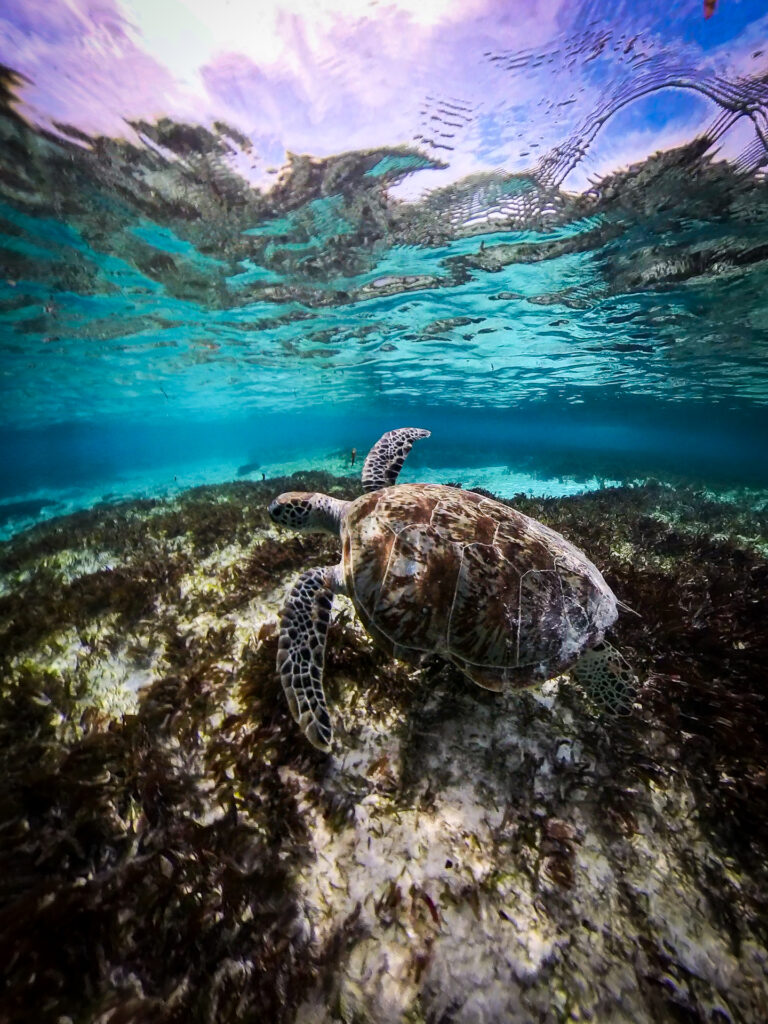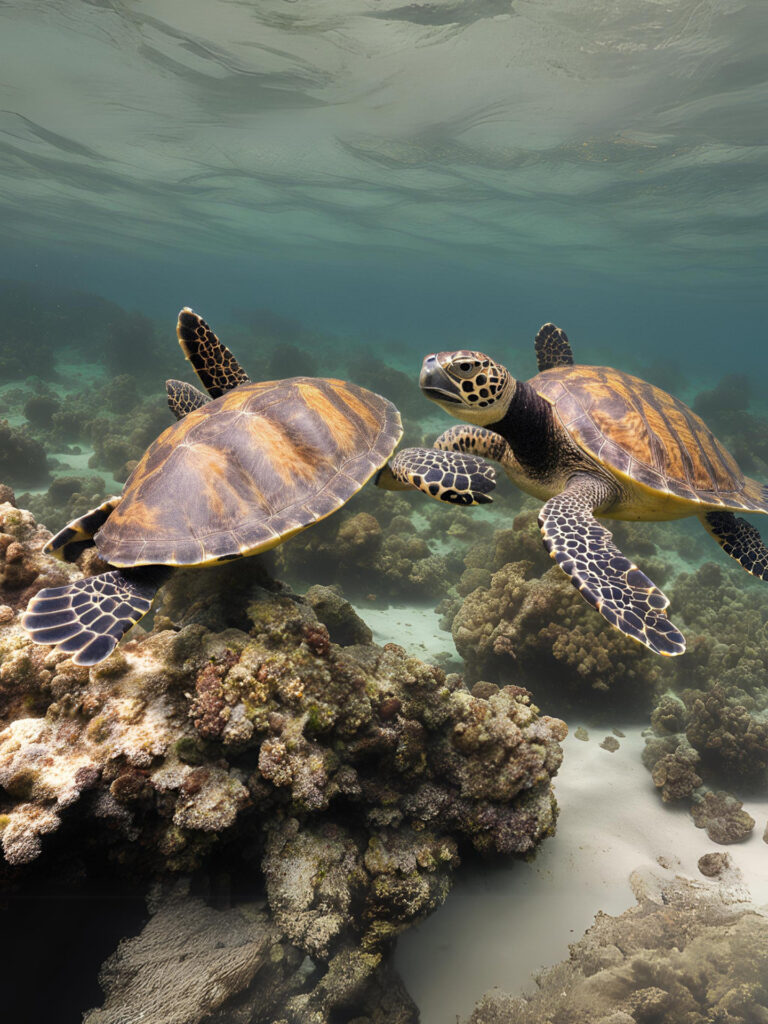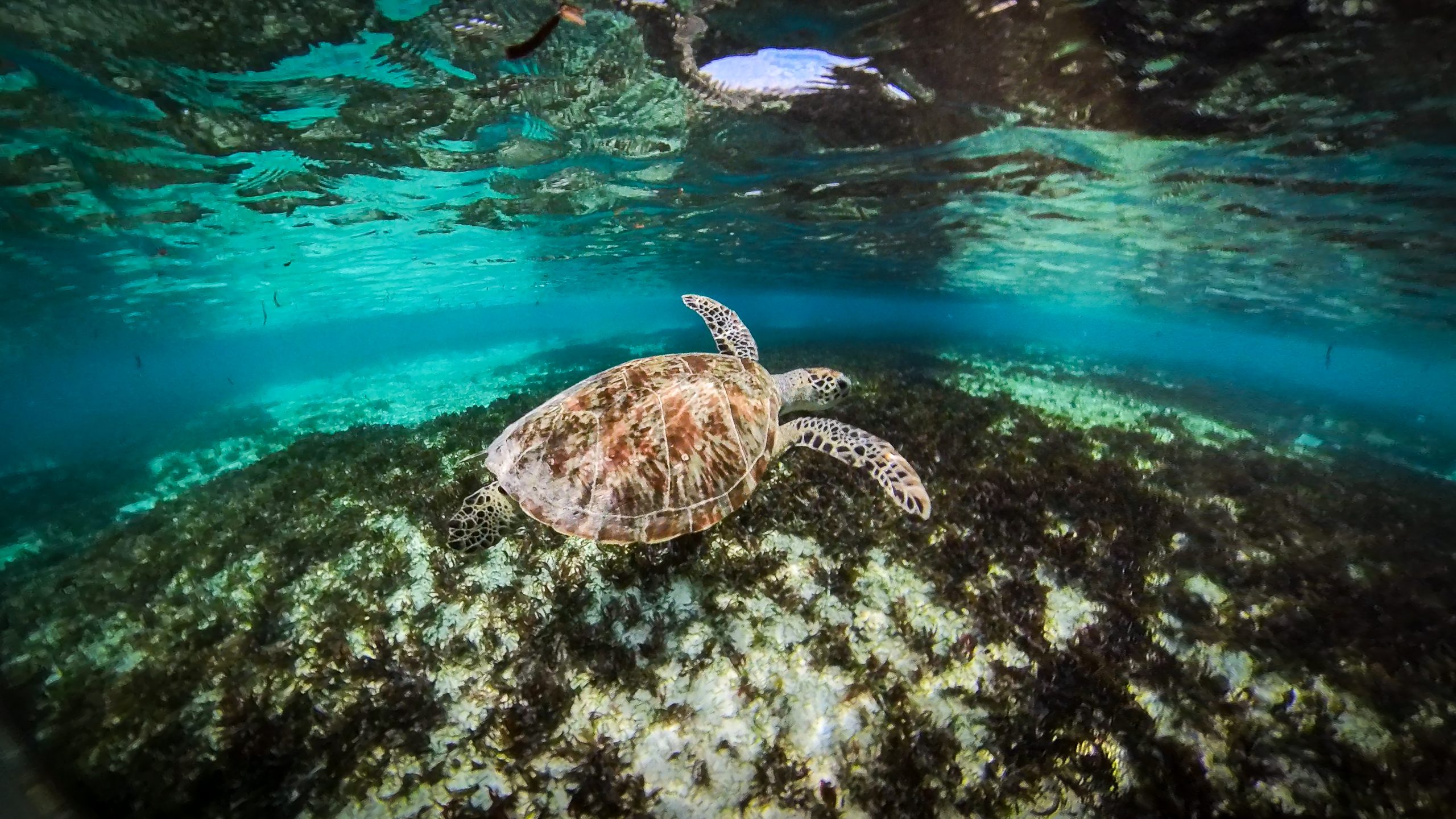Denis Private Island, located in Seychelles, is a sanctuary for Green and Hawksbill Turtles. This article explores the unique characteristics of these turtles and the island’s comprehensive conservation and sustainability initiatives aimed at preserving their natural habitat.
Turtles tend to come close to the shore, particularly along the east coast near Belle Etoile (East Coast). It’s a peaceful and tranquil bay surrounded by seagrass meadows, which attracts young turtles and rays, making it an ideal spot for snorkelling. Remember, the best time to snorkel is two hours before high tide. Another two locations where sea turtles are seen are: the House Reef (Point Mme Guichard), the area directly in front of the resort with a large variation of corals and fish, and the South Point.
While snorkelling, you will likely come across the charming Hawksbill Turtles. With patience, you might even catch sight of the elusive green turtles, which usually prefer to stay away from people and boats. We were lucky to swim with some beautiful Green Turtles who were intrigued by our presence during our visit.

Green Turtles
Green Turtles are known for their smooth, olive to dark brown carapace. Named for their green body fat, these primarily herbivorous turtles feed on seagrasses and algae. Renowned for their extensive migrations, females return to their birthplace beaches to lay eggs. Denis Private Island’s sandy shores serve as crucial nesting sites for these endangered turtles, supporting the island’s rich biodiversity.
Hawksbill Turtles
Hawksbill Turtles are smaller and more agile, recognised by their overlapping scales and pointed beaks. They primarily inhabit coral reefs, feeding on sponges and invertebrates, which are vital for coral health. The island offers a safe nesting environment, aiding in conservation efforts to protect these turtles from poaching and habitat destruction.

Conservation Efforts
Denis Private Island collaborates with the Green Islands Foundation on various conservation programmes:
- Habitat Restoration: Reviving native forests to support local wildlife.
- Marine Protection: Protecting surrounding waters to safeguard marine life.
- Sustainable Practices: Utilising sustainable farming and waste reduction techniques.
Conservation efforts success story
Seychelles is a leading example of turtle conservation in the Indian Ocean. NGOs, researchers, and the local community work together to protect the turtles. Denis Island is a sanctuary for one of the three largest nesting populations of Green Turtles remaining in the inner islands of Seychelles. It is also a safe nesting site for Hawksbill Turtles. Both species have specific nesting seasons: Green Turtles from May until September and Hawksbill Turtles from October to February.
Denis Island is more than a nesting site for this endangered species. The waters around the island are a crucial foraging ground for immature turtles. The seagrass meadows provide the young turtles with food for their growth and a safe haven from larger predators.





Green Turtle Facts
Longevity and Migration: They can grow up to 2 meters long and weigh up to 300 kg. They have a long lifespan, often living over 80 years. Female Green Turtles return to the same beach where they were born to lay their eggs, travelling thousands of kilometres, a behaviour known as natal homing.
Ecological Role: They maintain seagrass beds and coral reefs, crucial for marine ecosystems.
Rarity: Green turtles are classified as endangered, making sightings relatively rare compared to other marine species. They face threats from habitat loss, poaching for their meat and eggs, accidental capture in fishing gear, and pollution. This underscores the crucial role of conservation efforts, including protected areas and nesting site management, in ensuring their survival.





Sustainability Initiatives
Beyond conservation, the island’s sustainability measures include:
Renewable Resources: Using coconut palms for cattle feed to enhance milk production and reduce imports.
Self-sustaining Agriculture: Producing fresh, organic food locally, emphasising farm-to-table practices.
Eco-friendly Infrastructure: Employing a self-sustaining lumber mill for construction to lower the carbon footprint.





Denis Private Island showcases the impact of dedicated conservation and sustainability efforts. By protecting green and hawksbill turtles and their habitats, the island preserves its natural heritage and sets a standard for ecological responsibility!
How do you think other islands could implement similar conservation strategies to protect endangered species?
If you found our article helpful, please rate it at the top of the page and share it with your fellow travel enthusiasts, friends, and family! Stay tuned for more articles coming about sustainable initiatives and travel tips for Denis Private Island.
In the meantime, if you are interested in stunning mountain experiences, visit the Alpina Gstaad and Zermatt Gornergrat Matterhorn and explore the beauty of the Jungfrau Region.



